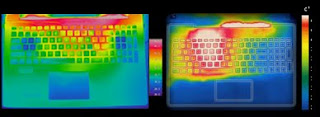If you’re looking for a machine that offers portability and power, HP has the answer for you. The new HP Spectre comes in at 10.4 millimeters thin, making it the world’s thinnest laptop, and packs powerful hardware like an Intel Core i7.
Ever since HP released the Spectre x360 the company has been clearly putting a greater emphasis on design and top-of-the-line materials. It's evident that this philosophy has come to all of HP's machines, from the thinning Envy line to even its budget Pavilion line, which are now painted with a tennis shoe-inspired design.
Now HP has released the Spectre, its most luxurious laptop yet, complete with gold bling and carbon fiber. The 13-inch Ultrabook also claims to be the world's thinnest notebook, while being the first laptop of this thinness (0.41 inches) to offer Intel Core i5 and i7 processors – a step up from the Intel Core M-powered MacBook.
While the HP Spectre is a looker, and substantial on the inside, it's not quite a home run for the storied PC maker.
Graphics: adapterIntel HD Graphics 520
Memory:8192 MB LPDDR3-1866SDRAM
Display:13.3 inch 16:9, 1920x1080 pixel 166 PPI, No, IPS UWVA, Corning Gorilla Glass, glossy: yes
Mainboard:Intel Skylake-U Premium PCH
Storage:Samsung PM951 NVMe MZVLV256, 256 GB
Connections:1 USB 3.0 / 3.1 Gen1, 2 USB 3.1 Gen2, 2 Thunderbolt, 2 DisplayPort,
Audio Connections: 3.5 mm Headset
Networking:802.11 a/b/g/n/ac (a/b/g/n/ac), Bluetooth 4.2
Sizeheight: x width x depth (in mm): 10.4 x 325 x 229 ( = 0.41 x 12.8 x 9.02 in)
Battery:38 Wh Lithium-Ion, 4 cells
Operating: SystemMicrosoft Windows 10 Home 64 Bit
CameraWebcam: HP TrueVision HD-Camera
Additional features:
Speakers: 4x Bang & Olufsen, Keyboard: Chiclet, Keyboard Light: yes, USB Type-C to USB Type-A adapter, 24 Months Warranty
Weight:1.16 kg ( = 40.92 oz / 2.56 pounds), Power Supply: 330 g ( = 11.64 oz / 0.73 pounds)
Ever since HP released the Spectre x360 the company has been clearly putting a greater emphasis on design and top-of-the-line materials. It's evident that this philosophy has come to all of HP's machines, from the thinning Envy line to even its budget Pavilion line, which are now painted with a tennis shoe-inspired design.
Now HP has released the Spectre, its most luxurious laptop yet, complete with gold bling and carbon fiber. The 13-inch Ultrabook also claims to be the world's thinnest notebook, while being the first laptop of this thinness (0.41 inches) to offer Intel Core i5 and i7 processors – a step up from the Intel Core M-powered MacBook.
While the HP Spectre is a looker, and substantial on the inside, it's not quite a home run for the storied PC maker.
Spec sheet
Processor:Intel Core i7-6500U 2.5 GHz (Intel Core i7)Graphics: adapterIntel HD Graphics 520
Memory:8192 MB LPDDR3-1866SDRAM
Display:13.3 inch 16:9, 1920x1080 pixel 166 PPI, No, IPS UWVA, Corning Gorilla Glass, glossy: yes
Mainboard:Intel Skylake-U Premium PCH
Storage:Samsung PM951 NVMe MZVLV256, 256 GB
Connections:1 USB 3.0 / 3.1 Gen1, 2 USB 3.1 Gen2, 2 Thunderbolt, 2 DisplayPort,
Audio Connections: 3.5 mm Headset
Networking:802.11 a/b/g/n/ac (a/b/g/n/ac), Bluetooth 4.2
Sizeheight: x width x depth (in mm): 10.4 x 325 x 229 ( = 0.41 x 12.8 x 9.02 in)
Battery:38 Wh Lithium-Ion, 4 cells
Operating: SystemMicrosoft Windows 10 Home 64 Bit
CameraWebcam: HP TrueVision HD-Camera
Additional features:
Speakers: 4x Bang & Olufsen, Keyboard: Chiclet, Keyboard Light: yes, USB Type-C to USB Type-A adapter, 24 Months Warranty
Weight:1.16 kg ( = 40.92 oz / 2.56 pounds), Power Supply: 330 g ( = 11.64 oz / 0.73 pounds)











































